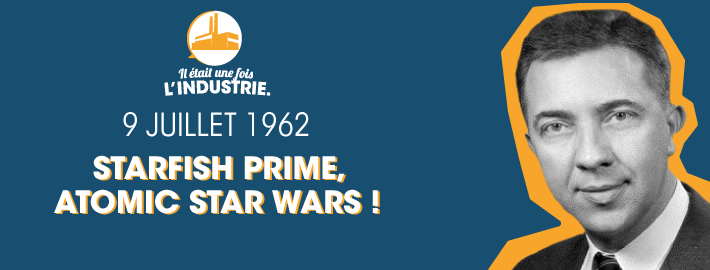GLOBAL
INDUSTRIE
News
Share on

9 July 1962: Starfish Prime, Atomic Star Wars!
What happened this week in the History of Industry? It is to answer this question that we invite you to rediscover, every week, a historical event which occurred around this time… in another age.
Today, let’s go back nearly sixty years to take a look at a nuclear test carried out under Kennedy’s presidency, a relatively little-known event but one which had consequences worthy of a (bad) science fiction movie.
THE ATOLL AND THE ATOM
The image is superb, and yet… The vast majority of those who witnessed the impressive artificial aurora which could be seen on the 9th of July 1962 over a large area of the globe covering Hawaii and New Zealand in particular had no idea that this spectacle was caused by a nuclear explosion 400 kilometers above their heads… Starfish Prime was the code name given to this American nuclear test conducted outside the Earth’s atmosphere. It was part of what those responsible called “Operation Dominic”. This was a series of 36 tests, including five at very high altitude to study in particular the process of destruction of missiles by this kind of bomb and its effects on radar and long-range communication systems.
The man behind this strange experiment was an American physicist and astronomer, James Van Allen, who, more than four years earlier, on the 1st of May 1958, had demonstrated to the National Academy of Sciences that the Earth’s magnetic field contains high-energy particles. Following this talk, he was contacted by the US Army to work on a top secret project aimed at determining whether this radiation belt could be diverted and directed against the enemy by means of exoatmospheric nuclear explosions.
On the 20th of June, nearly three weeks before the test in question, a first test conducted from Johnston Atoll in the Pacific Ocean ended in failure: the rocket’s engine stopped prematurely in flight, leading to the destruction of the missile with pieces of it falling to earth and plutonium contamination spreading over a vast area.
THE STAR WARS THAT NEVER HAPPENED
Despite this stinging setback, a second firing was immediately scheduled for the 9th of July 1962, and this time everything went as planned. At least to begin with… The 1.4 Megaton thermonuclear warhead, designed and built by the famous Los Alamos laboratory, exploded 400 kilometers above the ground. To measure its effects, scientists busied themselves in numerous test stations located on land, at sea but also in the air, with the help of some fifteen aircraft and 27 rockets launched from Johnston Atoll.
The results were not exactly what they expected, to say the least. While Starfish Prime failed to confirm the American military experts’ hypothesis, its electromagnetic effects, on the other hand, unfortunately exceeded their predictions…
On the ground, the electromagnetic pulse due to the explosion caused a voltage surge in some thirty public lighting power lines in Hawaii, nearly 1500 kilometers away from the detonation, blowing the fuses protecting 300 streetlights. The lights went out and radio stations went off the air over an area of several million square kilometers stretching all the way to Australia and New Zealand. Cars broke down. Phone lines caught fire. Garage doors opened and closed on their own. Alarms went off for no apparent reason.
The consequences were not limited to ground level, however. Of all the nuclear tests conducted in space, Starfish Prime created by far the most intense and most enduring radiation belt, one which lasted for several years. The effects were fatal to several satellites whose solar panels and electronic circuits were severely damaged. And a human catastrophe was only narrowly averted: at a meeting held on the 5th of September 1962 between President Kennedy, Defense Secretary Robert McNamara and representatives of NASA, it was decided to suspend nuclear tests in space for fear of possible repercussions for the health of the astronaut Walter Schirra who was to take off a few weeks later.
OTHER EVENTS WHICH HAPPENED THIS WEEK:
- 5 July (1941): the Belgian pilots Divoy and Donnet take off from the gloomy plain of Waterloo on board a biplane they have repaired and land in Britain
- 7 July (1752): birth of Joseph Jacquard, inventor of the programmable mechanical loom
- 9 July (1910): the French pilot Léon Morane flies for the first time at over 100 km/h
- 9 July (1979): the Voyage 2 probe flies over Jupiter
- 10 July (1938): Howard Hughes flies around the world in a record time of 91 hours and 14 minutes
- 10 July (1962): the American satellite Telstar 1 makes the first live broadcast of television images above the Atlantic Ocean
- 10 July (1976): in Seveso in northern Italy, the explosion of a chemical reactor producing herbicides causes a release of dioxins into the atmosphere
- 11 July (1979): Skylab, the first space station launched by NASA, disintegrates on re-entry into the atmosphere
2021.07.05